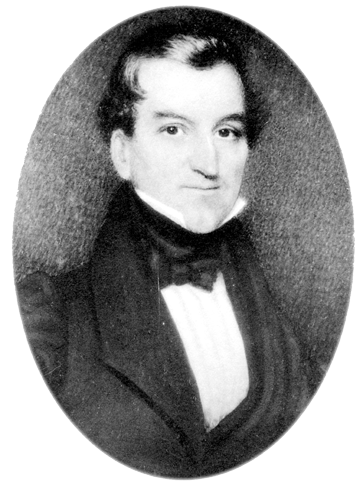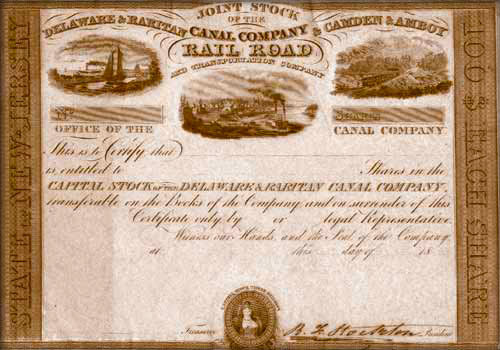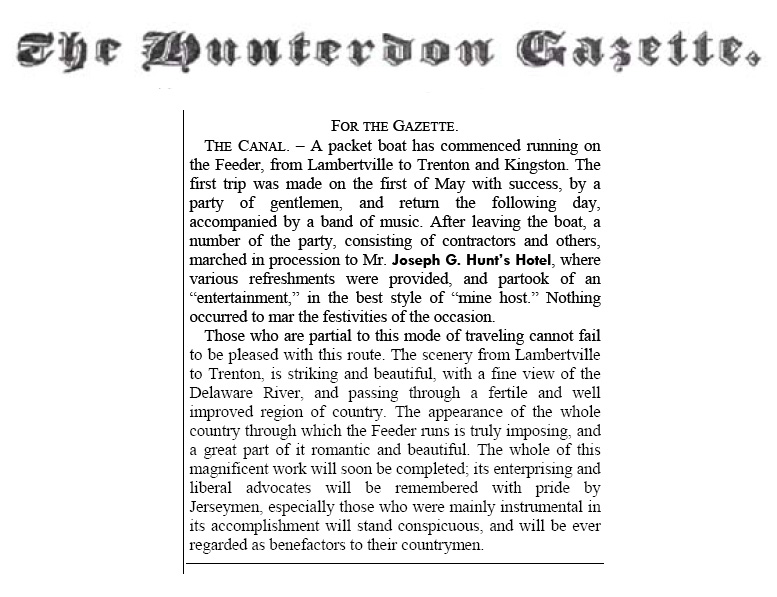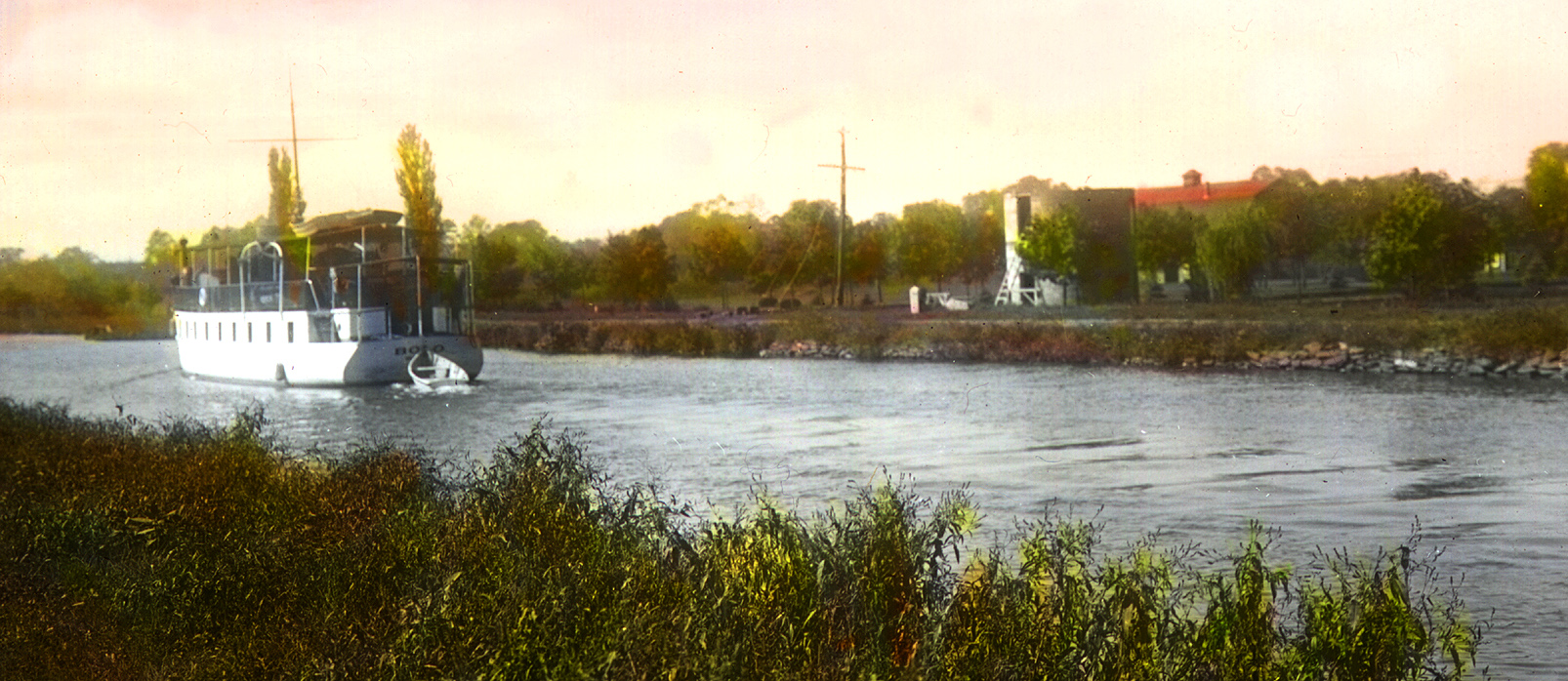"You have constructed for sixty-five miles, through the heart of New Jersey, the most spacious canal, which adds year after year, thousands to the value of her agricultural interests, while it carries with it wealth and happiness to her citizens generally, and which may be referred to as a lasting monument of the sagacity of New Jersey statesmen, and of your patriotism and munificence."
James Parker - 1840 Report of the Joint Board of Directors to the Stockholders
The Birth of a Canal
During the early nineteenth century the industrial and transportation revolutions were in their infancy but the expectations of innovation, efficiency, growth and wealth that they promised would soon overtake the American imagination and change its society as the century progressed. One such grand transportation achievement was the opening of the Erie Canal in 1825. Its instant success ignited “canal fever” across the young country – canal projects reaching inland markets exploded across the eastern seaboard. These man-made waterways opened grand possibilities of expansion, development and untapped western markets. They were the new exciting internal improvement discussed by many – efficient transportation routes that could link resources, manufacturing centers and markets. And yet, while canals were new to the United States, they were well established and used across Europe and Asia. New Jersey’s Delaware and Raritan Canal was envisioned as just such an improvement. An inland waterway that reached across central New Jersey to provide a direct, quick and safe transportation route for the movement of freight between Philadelphia and New York. The idea had success written all over it.

While New Jersey roadways may have expanded from the early colonial period through the 18th century, they had not greatly improved by the 19th century. Travel remained difficult and always weather dependent. New Jersey lay between two busy centers of commerce – New York and Philadelphia – and the movement of goods, produce and local commodities between them was big business. Overland shipments could be laborious and prone to delays due to poor roads. Ocean transport, while more reliable, quicker and efficient, was weather and tide dependent. Like overland travel, delays were common. For this reason, merchants and businessmen like John Neilson and his son James of New Brunswick, were interested in and supported transportation improvements such as turnpikes, toll roads and especially canals to connect inland regions and markets.
The turn of the 19th century ushered in the beginnings of the turnpike and steamboat eras which further served to improve transportation connections from New Brunswick to New York and Trenton to Philadelphia. Men such as Cornelius Vanderbilt, who established a successful steamboat line in New Brunswick, made their fortunes from these innovations. With backing and investment from the business and political communities, improvements to facilitate the ease of movement for people and products began early in the century. In 1807 the Trenton and New Brunswick Turnpike or “Straight Turnpike” (Route 1 today) opened for operation and while its surface was gravel, stone and timber, the majority of roads crossing central New Jersey remained little more than improved dirt paths. The Straight Turnpike was an improvement and viable alternative, but transportation was still a laborious and costly proposition. Change, however, was on the horizon.
The opening and quick success of the Erie Canal in New York ushered in fevered interest in canal building here in New Jersey. Talk of a canal across the central part of the state, essentially expediting trade between New York City and Philadelphia, was not new and is thought to have originated with William Penn in the 1690s. Attempts to approve such a project in the New Jersey legislature had taken place three times early in the 19th century but it wasn’t until the fourth attempt that the Delaware and Raritan Canal charter of 1830 was finally passed due in large part to the dogged determination, lobbying expertise and lavish entertaining efforts of James Neilson – a staunch believer in the potential financial benefit such a canal would pose.
Canal? Railroad? Both.

At the same time that Neilson was lobbying for passage of the Delaware and Raritan Canal Charter, others were working towards securing the same permission to begin construction on the first railroad line across the center of the state including business interests in New York. The canal verses railroad battle had been in play since 1815 with the passing of John Stevens railroad charter. By the mid-1820s it hit a crescendo. This innovation generated much excitement and many in the business community saw its economic potentials. While still untested and untried, the railroad had many supporters and eager investors.
As James Neilson lobbied for the canal, backers of the Camden and Amboy Railroad and Transportation Company fought equally hard in Trenton for permission to begin work on this promising new internal improvement. Their goal was to connect the same key traffic hub between New York City and Philadelphia – the very transportation corridor planned for the water route. The rivalry was fierce, and both sides fought hard to persuade the legislature to support their venture over the other. It was a fight to win the upper hand for the potential transportation dollars to be made. In the end a compromise was reached – to pool the stock of both companies and create a railroad–canal partnership.
In early February of 1831 the Delaware and Raritan Canal Company and the Camden and Amboy Railroad and Transportation Company, also known as “The Joint Companies,” was formed. It was to be a 30-year merger/partnership that provided protection against competition for both the canal and the railroad. In that time the railroad would come to focus on passenger service and the canal on the movement of goods and freight. It was a marriage where each partner understood their/its role; a partnership that served the joint stockholders well. With the investment monies for both undertakings now thrown into one pot, and competition between them removed, construction on both began in earnest.
Building the D&R

Since boats navigated the Delaware River to Bordentown and the Raritan River to New Brunswick, those two cities were selected as the canal's two terminuses. To supply water to the main canal at its highest elevation in Trenton, a 22-mile feeder canal would be dug from Bulls Island on the Delaware River south to Trenton where it would meet and “feed” river water into the D&R’s main stem. Although the feeder’s primary purpose was to supply water to the main canal, it was navigated by mule-drawn canal boats from the time of its completion. By the 1840s changes were made to the feeder. An outlet lock into the Delaware River was constructed that allowed vessels from Pennsylvania's Delaware Division Canal access to the D&R’s feeder canal at Lambertville. This “short-cut” was primarily used by canal boats carrying Pennsylvania coal directly to markets across central New Jersey to New York City.
The chief engineer hired to oversee the D&R’s construction was a veteran from the Erie Canal project – Canvass White who worked under the Erie’s chief engineer Benjamin Wright. The White family lineage in America reaches back to the1630s with the immigration of Canvass' five times great grandfather John White who was among the first settlers of Hartford, Connecticut in 1632. His grandfather Hugh White, a veteran of the War for Independence, moved his family from Connecticut to the wilderness of central upstate New York in Oneida County where he settled and founded Whitestown . It was here in 1790 that Canvass was born and raised. Although he suffered from frail health (something that dogged him throughout his short life), Canvass possessed an inquisitive scientific mind, a drive to learn and a natural instinct to excel and lead. He attended and graduated from Fairfield Academy in 1811 which equipped the young man with an education that was well-suited to needs of a transitioning country soon to be in need of innovative thinkers, problem solvers, builders and leaders.
Canvass was in his mid-twenties when the first shovels hit dirt on the Erie project; the timing and location couldn't have been better! Hired in the spring of 1816 as part of the Erie project's surveying crew, his skills and likable personality stood out; he soon became Benjamin Wright's principal assistant. Little was known of canal engineering in America at the time and as an educated, accomplished student of science, mathematics and surveying, Canvass shined and excelled. In 1817, he was selected by Benjamin Wright and New York Governor Dewitt Clinton to visit England. His mission was to study the construction, building materials, tools and approaches used in the country’s extensive canal system. It proved to be an invaluable trip; a comprehensive research assignment covering over 2000 miles of canal property that included surveys of bridges, culverts, aqueducts, locks and other features. He took copious notes, absorbed information and returned to the Erie project armed with much needed knowledge and skills. It was his scientific mind and innovative thinking that contributed to the discovery of a cost-effective method to produce hydraulic, or water-proof, cement in America which was an invaluable game-changer in the construction of locks, aqueducts and other masonry features along the Erie project and others throughout the 19th century.

The Erie Canal was Canvass White's hands-on, "trial by fire" education. He proved himself to be an accomplished engineer, surveyor, problem-solver and meticulous, detail-oriented project manager; his work was in high demand in the early days of internal improvements and industrialization. The officers of the Delaware and Raritan Canal Company were indeed lucky to have him not only do the surveying work for the waterway but to hire him as its chief engineer. By 1830 White got to work overseeing construction contracts, hiring section foremen and planning the schedule of work to be done over the course of the next few years. Perhaps due to the stress of overseeing several projects in conjunction with the final phase construction of the D&R, as well as overwhelming financial concerns, his health faltered. In the fall of 1834 he traveled to Florida in the hopes that the milder climate would prove healing. Unfortunately it did not. He passed away in St. Augustine on December 18, 1834; he was 44 years old. His body was returned to New Jersey and laid to rest in Princeton. Luckily Canvass lived long enough to see the completion and official opening of his final canal project.

The construction years, between 1831 into 1834, opened a variety of labor opportunities in the towns where the D&R was to be built. Many skilled men of property became section contractors and builders while scores of unskilled local men and farmers took on labor jobs that included the arduous tasks of digging the ditch, moving earth and removing trees. These local workers were supplemented in large numbers by a moving migratory labor force filled mostly by men from Ireland. Many of these laborers, though not all, were specifically recruited by Canvass White and others to make the crossing to the United States when the Erie Canal project was begun. When finished in 1825, those Irish born workers moved on to other canal construction projects getting underway elsewhere from New England southward. Still others continued to immigrate to the United States after the completion of the Erie Canal as word spread that work was to be had here first on canals and soon after on the railroads. Many were drawn to New Jersey’s D&R project by the slightly higher wage offered – $1 a day and 25 cents for each tree stump pulled and removed!

Work progressed steadily and by the spring of 1834, short celebratory trips between Lambertville and Kingston were reported in the local papers. While various projects remained to be completed, the Delaware and Raritan Canal officially opened to great fanfare on June 25, 1834. Dignitaries, including Governor Peter Vroom and others, traveled the entire length of the main canal from Bordentown to New Brunswick on boats borrowed from the Chesapeake and Delaware Canal. Residents along the route came out to cheer as the boats made the 44-mile trip. Upon arrival in New Brunswick a grand celebration commenced with a 24-gun salute and a parade. The festivities ended with an elaborate dinner. The D&R Canal was opened for business. Goods could now be transported between Philadelphia and New York City in a mere two days! This was transportation progress.
Coal, Swing Bridges & Vessels of All Kinds

For nearly a century after it opened, the D&R Canal was one of America's busiest navigation canals even occasionally eclipsing the tonnage and profits of the Erie Canal. Its peak years were the 1860s and 1870s when Pennsylvania coal was transported through the D&R Canal to feed the city of New York's industrial boom. During this period, 80% of the total cargo carried on the canal was Pennsylvania coal.
While it wasn’t New Jersey’s only transportation canal, the D&R had the advantage of being constructed over relatively level topography across the narrowest, central part of the state; its highest point was 57 feet above sea level at Trenton. It only required 14 lift locks to overcome the elevation changes from Bordentown to New Brunswick. By the 1850s its depth was increased to 8 feet to accommodate the needs of larger vessel with heavier loads.
Additionally, all of D&R’s bridges were movable allowing a large variety of boat traffic to ply the canal including the steam powered vessels that first made use of the navigation waterway in 1843. Other canals, such as Pennsylvania’s Delaware Division Canal, had height restrictions due to their stationary bridge crossings. By contrast, the D&R’s A-framed swing bridges opened boat traffic to an assortment of vessels from the mainstay mule-drawn boats to larger steam powered tugs, tall-masted ships and pleasure craft of all kinds. The towering A-Framed beams that supported the long wooden bridge decks could be seen from a distance while plying the waterway; they made quite the majestic impression and gave the D&R Canal a distinctive look in the 19th century. With turn of the 20th century and the introduction of motorized vehicles, the A-frame bridges, designed to accommodate horse, carriage and wagon traffic, were replaced by shorter king post swing bridges..
Decline of the Canal

By the end of the 19th century, canal use was declining throughout the country. The speed and power of the railroad inevitably overtook the slower pace of the canal era. The D&R Canal's last year of operation at a profit was 1892, but is stayed open through the 1932 shipping season giving it a 98-year run. After the canal closed that year it sat unused several years. Ownership was turned over to the State of New Jersey in 1936. After long debate, it was decided to rehabilitate the old canal system to serve as a water supply - a purpose it still serves today.
The conversion of the D&R from a transportation route to a water supply for the State of New Jersey saved it from an untimely demise. In the years before it became an official park – the mid-1930s to the early 1970s – locals who lived along its banks used it for recreation while the State maintained it as a water supply. In this 40-year period the D&R slowly made the transformation from working canal to linear park. The towpath, no longer cut and maintained, soon became overgrown with trees, wild flowers, bushes and grass. Today, tree growth has replaced carefully manicured space in most areas along this former transportation corridor creating a canopy of shade in many sections.
Due to a strong, local grassroots effort to preserve the waterway from encroachment, pollution and development, the canal and its remaining structures were entered on the National Register of Historic Places in 1973. A year later, in 1974, over 60 miles of the canal and a narrow strip of land on both banks were made an official state park. A portion of the Belvidere-Delaware Railroad corridor from Bull's Island to Frenchtown was added to the park in the 1980s. The park's trail system was designated a National Recreation Trail in 1992 and is a part of the East Coast Greenway. Today it is used by millions as a much loved and needed recreation corridor in Central New Jersey



